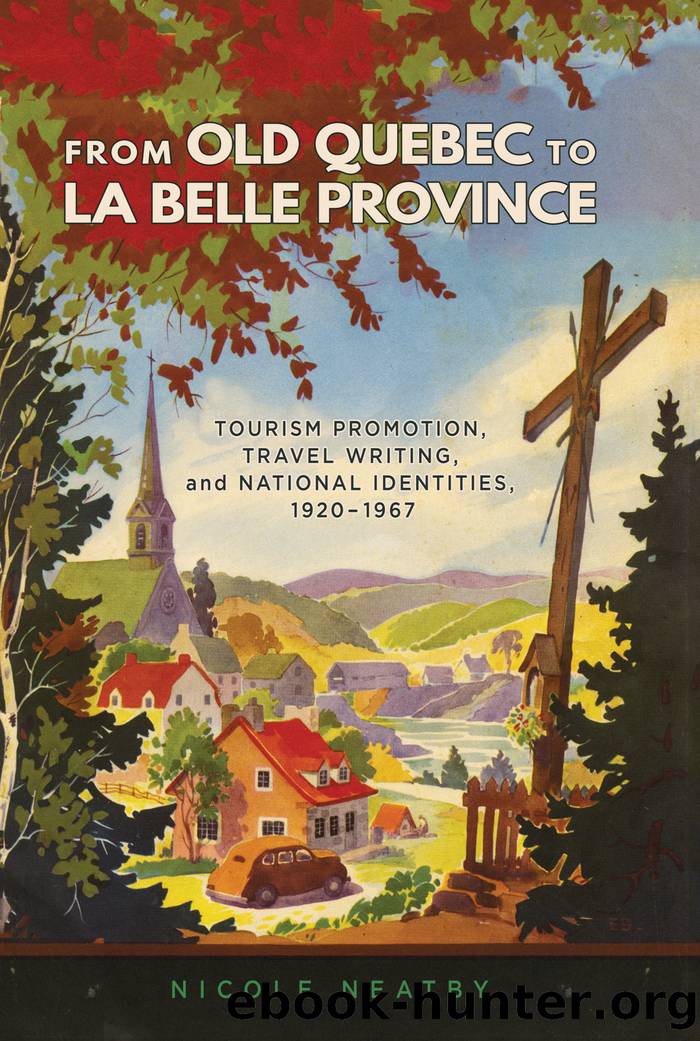From Old Quebec to la Belle Province by Neatby Nicole;

Author:Neatby, Nicole;
Language: eng
Format: epub
Publisher: McGill-Queen's University Press
Published: 2018-10-14T16:00:00+00:00
6
FROM OLD TO BELLE
During the early 1960s, tourism promoters markedly changed the way they represented the province. Instead of foregrounding what was old about Quebec, they changed course, highlighting, instead, distinctly contemporary and modern pleasures. âOld Quebecâ and âLa province de Québecâ were replaced with âLa Belle Province.â More significantly, Quebec tourism itself was divested of the role many traditional nationalists ascribed to it in order to revitalize a French Canada, where ânaught shall suffer change.â This rebranding can only be understood by taking into account the context in which it occurred â a time of remarkable political and social transformation, otherwise known as the Quiet Revolution.
For the tourism industry, the 1960s was the decade during which trends identified in earlier decades accelerated at an unprecedented pace. Those who, in the 1930s, predicted tourism would stimulate economic development were proven right, as tourism continued to be a growing source of revenue beyond the Second World War. In fact, by the 1950s, âmass tourism truly took flight in North America [as] vacations ⦠came to represent almost everything good about North American culture.â1 During the immediate postwar period in Quebec, the number of visitors tripled, and by the 1960s tourism âstood in third place ⦠after pulp and mines.â2 Such economic indicators led Department of Industry and Commerce officials to be optimistic, arguing, âthe tourism industry deserves to retain our attention all the more as it can ⦠increase or decrease of our commercial trade deficit.â3
However, all was not well. Government promoters never ceased to caution that this lucrative industry remained vulnerable, as competition for the tourist dollar was intensifying. While alarm bells had sounded before, by the 1960s new and potentially more threatening developments were emerging. The rapidly growing affordability of international air travel featured high on the list, as it meant that popular European countries, as well as other more exotic destinations, notably Mexico, were suddenly more accessible.4 Although, by the early 1960s, Canada had succeeded in reversing its travel deficit, those working in the industry were only too aware of how fragile such reversals were, which made such warnings more convincing. More worrisome still was the mounting evidence that Americans from the northeastern states were increasingly heading for closer Canadian destinations, especially Ontario.5 And US tourist promoters, more than ever, were pulling out all the stops to encourage their citizens to travel at home.6 In short, Quebec tourist promoters could no longer assume that Quebecâs ânatural advantages,â such as its geographical proximity and its distinct French character, would be sufficient drawing cards for its principal American tourist market.
Tourist-conscious as never before, the Quebec government undertook major changes to meet these challenges. For one, tourism was given a much greater visibility in state bureaucracy, and politicians took on a more proactive role. During the 1960 election, Jean Lesage, Quebec Liberal Party leader, running under the slogans Maîtres chez nous (Masters in our own house) and Il faut que ça change (Itâs time for a change), promised to create a Department of Tourism.
Download
This site does not store any files on its server. We only index and link to content provided by other sites. Please contact the content providers to delete copyright contents if any and email us, we'll remove relevant links or contents immediately.
| Africa | Americas |
| Arctic & Antarctica | Asia |
| Australia & Oceania | Europe |
| Middle East | Russia |
| United States | World |
| Ancient Civilizations | Military |
| Historical Study & Educational Resources |
Machine Learning at Scale with H2O by Gregory Keys | David Whiting(3633)
Never by Ken Follett(3528)
Fairy Tale by Stephen King(2950)
The Man Who Died Twice by Richard Osman(2808)
Oathbringer (The Stormlight Archive, Book 3) by Brandon Sanderson(2633)
Will by Will Smith(2580)
Rationality by Steven Pinker(2149)
The Dark Hours by Michael Connelly(2078)
The Dawn of Everything: A New History of Humanity by David Graeber & David Wengrow(2017)
Can't Hurt Me: Master Your Mind and Defy the Odds - Clean Edition by David Goggins(2004)
Friends, Lovers, and the Big Terrible Thing by Matthew Perry(1994)
Principles for Dealing With the Changing World Order: Why Nations Succeed and Fail by Ray Dalio(1894)
HBR's 10 Must Reads 2022 by Harvard Business Review(1697)
A Short History of War by Jeremy Black(1669)
Go Tell the Bees That I Am Gone by Diana Gabaldon(1599)
515945210 by Unknown(1520)
443319537 by Unknown(1395)
Kingdom of Ash by Maas Sarah J(1389)
A Game of Thrones (The Illustrated Edition) by George R. R. Martin(1368)
